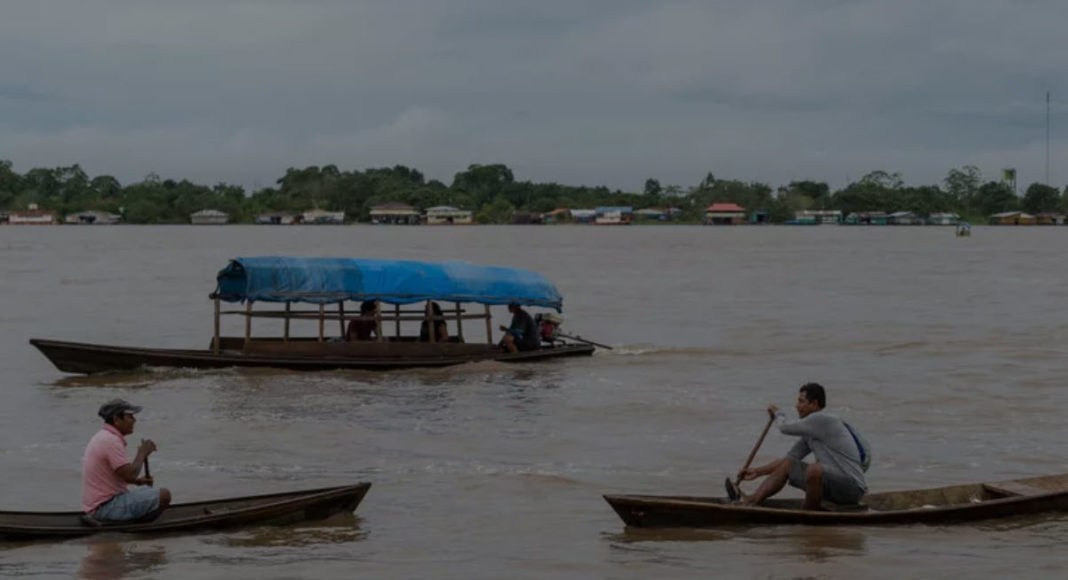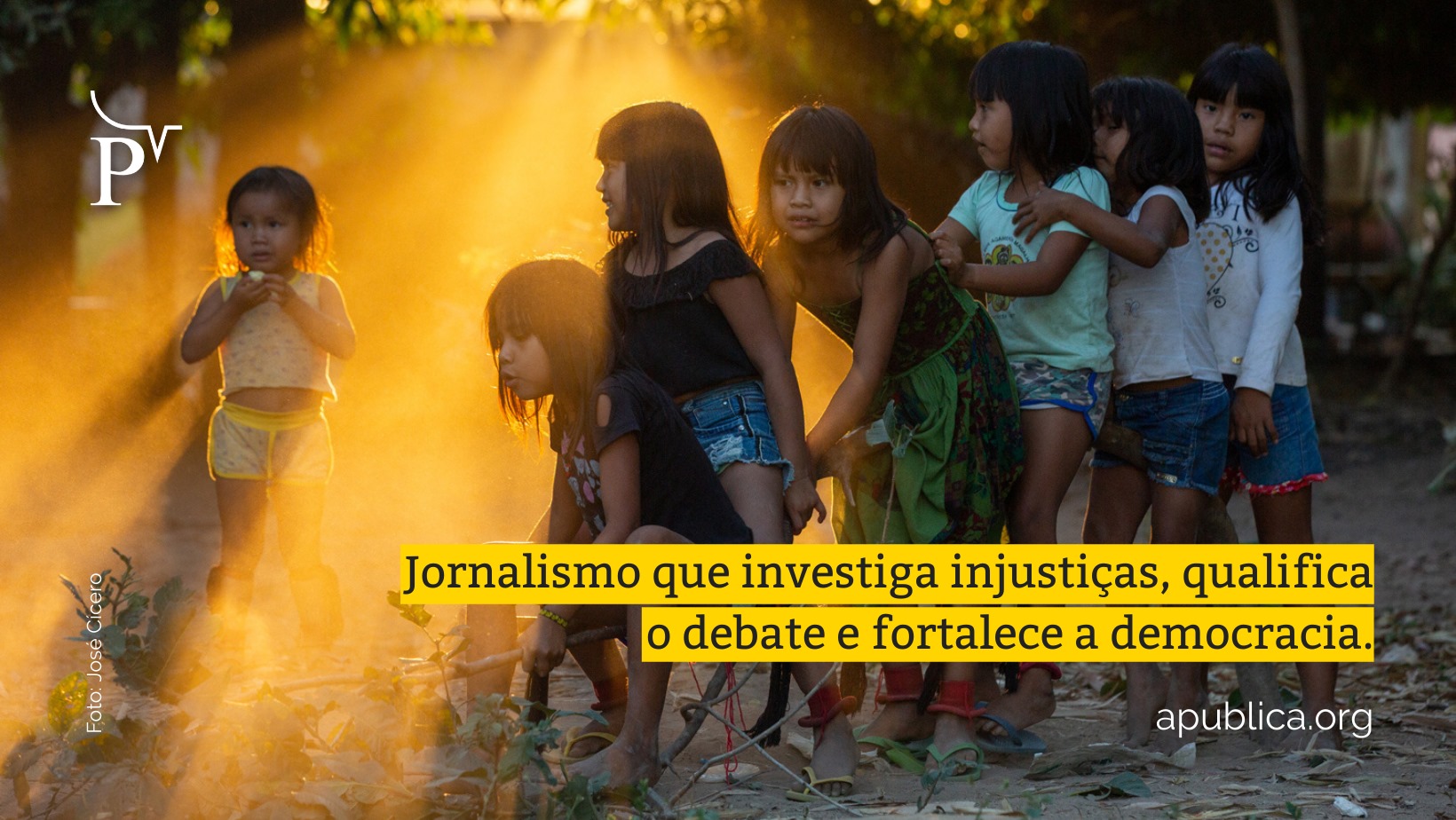This article was first published here in Portuguese by Agência Pública and translated to English by Matty Rose for Latin America Bureau.
You can subscribe to the biweekly Agência Pública newsletter in English here.
Main image: On the border with Brazil, coca bosses send boats out to recruit indigenous Brazilians from communities that live along the river.
Genaro, a motorcycle taxi driver, arrived on his bike wearing jeans, a blue t-shirt and a black cap to offer some respite from the blaze of the midday sun of an Amazonian summer. A member of the Tikuna Indigenous group, Genaro agreed to meet Agência Pública’s reporters to share the story of the personal ordeal of how his son was arrested for drug trafficking in Colombia. Genaro’s surname has been withheld in order to protect the identity of his son.
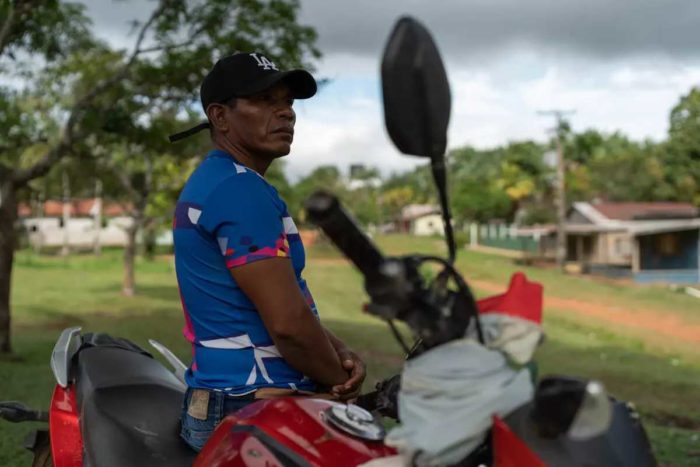
Claudio* was arrested on April 9 this year in Puerto Nariño, a city on the banks of the Amazon river which lies on the border between Colombia and Peru. Agência Pública has obtained documents from the Colombian authorities that confirm the arrest of the young man for cocaine possession. Claudio was taken to a jail in the neighboring Colombian city of Letícia, which borders the Brazilian municipality of Tabatinga. These two “sister cities” of Letícia and Tabatinga lie in such close proximity to one another that they form what is almost a single urban area wedged into what is known as the “Amazonian Trapezium”, or the triple border between Peru, Brazil and Colombia.
Before being arrested, Cláudio held down a job that is ever more common among the region’s Indigenous communities: harvesting coca leaves on the Peruvian side of the border, which are then used for the production of cocaine.
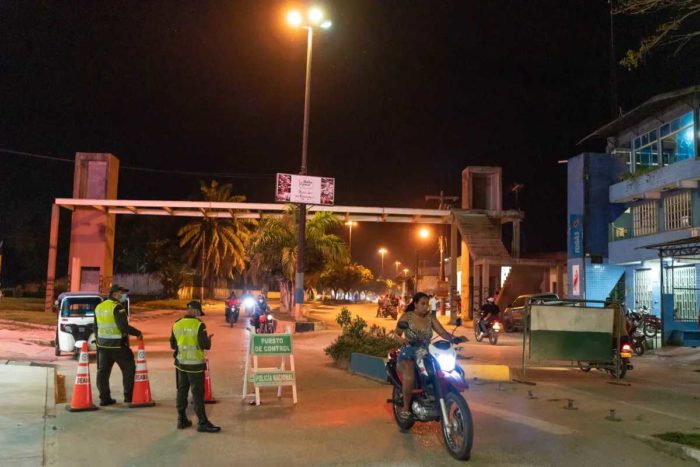
Peru is just a few hours by boat from the Indigenous communities of Benjamin Constant and other neighboring municipalities in the Alto Solimões region, in the Brazilian state of Amazonas. According to the accounts of those interviewed by Agência Pública’s reporters, boats are sent over from Peru during the coca harvest season by the Peruvian coca bosses in order to recruit laborers from the communities living along the banks of the Solimões River.
The offer of work is appealing to Indigenous people, and especially Indigenous youth, who live in cities where employment opportunities are scarce. The municipalities of the Alto Solimões region are marked by high levels of social inequality and low levels of human development. Of the nine cities in the region, Tabatinga is the only one to score above the Human Development Index (HDI) categories of “low” or “very low”, according to data from the Atlas of Human Development in Brazil.
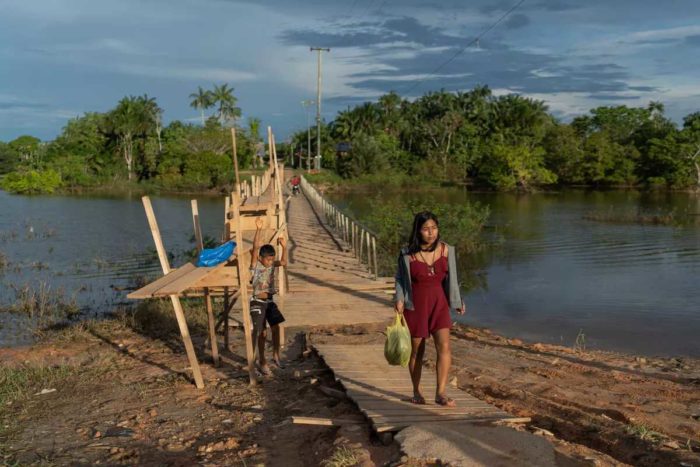
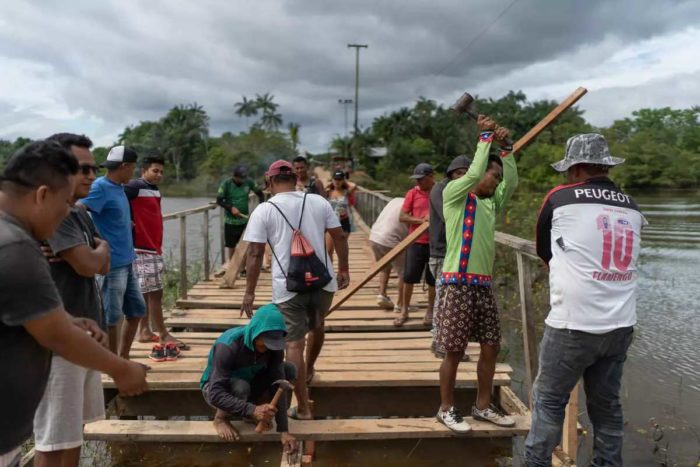
According to the most recent census data, the Alto Solimões region has the highest concentration of Indigenous people in Brazil. Nearly 65,000 Indigenous people live in the urban areas of the region’s municipalities, according to data gathered by the Amazonas Center for Socio-Environmental Studies (Núcleo de Estudos Socioambientais do Amazonas, NESAM). If Indigenous people living on Indigenous territories in the rural areas of the Alto Solimões are added to the equation, the total number of Indigenous people in the region reaches nearly 123,000, coming from at least 13 different ethnic groups that stretch across 35 Indigenous territories, some of which have been fully demarcated and others that are in different stages of the demarcation process.
Genaro spoke of how his son was doing a technical course in nursing when he was first invited by another young Indigenous member of his community to work on the Peruvian coca plantations.
“First he spent a month there, and came back with nothing. Then he went back to spend another three months there and never came back. His mother started to get worried, as did I. Another week went by and one of his colleagues told us that he had been arrested. We were scared, [since] we don’t involve ourselves in drugs,” the Tikuna motorcycle taxi driver remembered, speaking slowly, pausing from time to time to look into the distance.
Genaro heard that his son and a number of others working on the Peruvian plantations had been stopped while carrying cocaine aboard a “pec pec”, a small motor boat. The circumstances surrounding Cláudio’s arrest have not been fully clarified by the Colombian authorities. One hypothesis, put forward by others from the community who also worked on the coca fields, is that Cláudio had been acting as a drug mule, transporting drug shipments from one location to another. The same sources also claimed that it is common for some laborers to go from working in the fields to working as drug mules.
The most important thing for Genaro, however, are the conditions facing his son in jail. Genaro said that his son had already been hospitalized in Letícia after being assaulted while in prison. As the father to another three children, Genaro struggles to pay for the basic provisions he sends to his son, locked up in another country, nor does he have the resources to get a lawyer to help his son’s case, and knows little about how the case is progressing through the Colombian courts. “I barely ever sleep, [lying awake] thinking… [our] family is suffering a lot,” he said.
Young lives ruined
A further two Indigenous people from the Alto Solimões region, who have worked on the plantations in Peru for decades, spoke to Agência Pública’s reporters on the condition of remaining anonymous. Despite the coca fields having existed in the border area for a long time, the interviewees claimed that recruitment drives have intensified over the last few years – a view shared by other locals and community leaders alike.
“Here it’s very simple. We’re on the triple border. There are no controls, no security on the border. People arrive here on the Javari River with drugs, with arms, and they’re not checked by anybody,” said Isaque Almeida Bastos, who is the leader of the Indigenous community of Filadélfia, in Benjamin Constant.
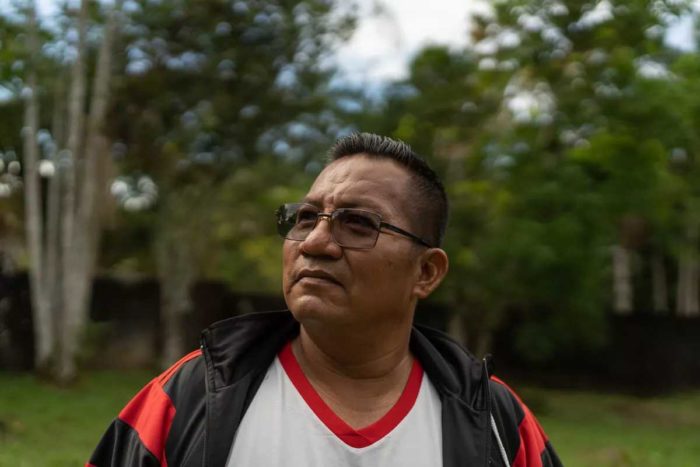
According to data from the United Nations Office on Drugs and Crime (UNODC), between 2015 and 2017 alone there was a 24% increase in the area of land used for coca leaf cultivation in Peru, rising from 40,300 hectares (99,600 acres) to 49,900 hectares (123,300 acres).
The increase was most prominent in the Bajo Amazonas region of Peru, in the Amazonian department of Loreto, where the border with Colombia and Brazil is located. Coca leaf cultivation in this region increased 41% between 2016 and 2017.
The main transportation route for coca leaves produced in this region is along the Amazon River, passing through the city of Leticia and onwards into Brazil. The UNODC report also pointed to the role that the Ucayali and Yavarí rivers, both in Peru, play in facilitating the onward flow of drugs produced in the country.
The vast majority of the cocaine produced in Peru is not intended for the internal market, with the country having one of the lowest consumption levels of the drug in Latin America, according to data from the 2019 Inter-American Drug Abuse Control Commission (CICAD). As well as supplying Brazil’s vast internal market for cocaine – the second largest in the world –, Europe is one of the drug’s main destinations. Brazil is now “the main route for transporting cocaine to Europe”, according to the UNODC report.
“Today, Peru is the largest producer of cocaine in the triple border region,” claimed Victor Mota, head of the Federal Police Department for Drug Prevention and Repression (DRE) in the state of Amazonas.
This view is backed up by Aiala Colares Couto, a geographer and researcher from the Pará State University (UEPA). “We can see this from the Federal Police’s data on cocaine seizures in Brazil. For the last four, five years, most of the cocaine has been coming from Peru,” the researcher claimed.
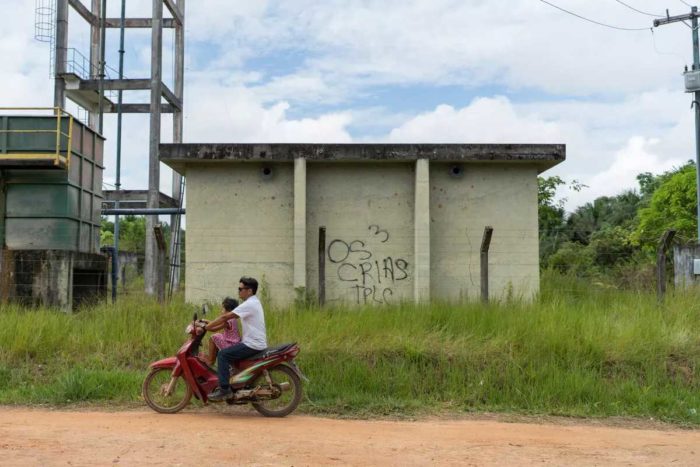
Workers in the coca fields
“Over the last few years, a lot more coca fields have appeared on the border,” said José*, a Indigenous Tikuna who also lives in one of the communities visited by Agência Pública’s reporters. José spoke with the authority of someone who has spent the last 13 years working in the coca fields. His first experience on the plantations was when he was 18 years old. Having given up on his studies and short of employment opportunities, José decided to board one of the Peruvian boats that used to dock in his community and spend his first harvest season on the coca fields.
“There’s no work here. Over there, I earn at least 60 reais ($11.50) a day. The bosses give us board, food, everything. When you finish [the work in] one field, you can go to another, and continue earning more money”, José said.
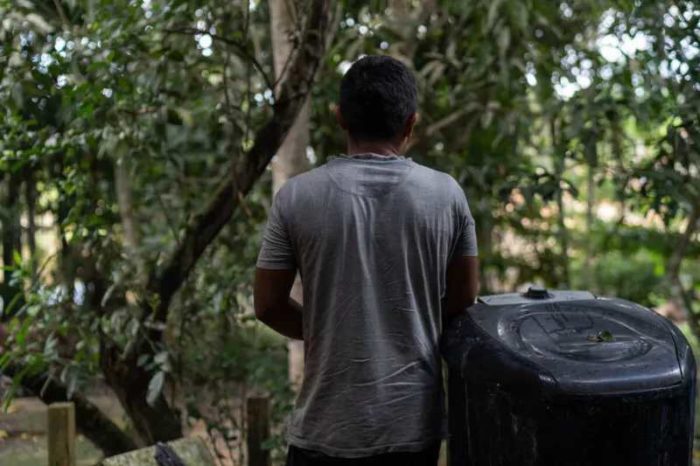
José said that the most well paying job he had ever had in the city was unloading boats in one of the local ports, from which he earned around 400 reais ($76) a month. He said that he could make up to 4,000 reais ($760) in a week from harvesting coca leaves on the plantations, which would then be used to make coca paste – the crude extract which can later be refined to make cocaine – in the plantations’ laboratories.
José also said that he has recruited other Indigenous people to work on the farm, and had received a bonus for each new worker he recruited. Despite the overt presence of the coca bosses’ sicarios, or hitmen, on the coca plantations – always heavily armed with rifles or machine guns – José said that he has never personally witnessed any acts on violence. He has, however, heard stories of workers being killed for trying to steal the coca paste, and of coca farms being the target of armed invasions from other rival trafficking gangs. Despite the work in the coca fields being José’s main source of income, he says this alone does not provide enough to live on. Juan* is an Indigenous Tikuna from Peru who crossed the border into Brazil 27 years ago when he fell in love with a Brazilian Tikuna woman. He told Agência Pública’s reporters that he first worked on the coca plantation when he was 10 years old and still living in Peru. Now in his forties, he has more than three decades of experience working on the coca fields and has even introduced his children to the same line of work.
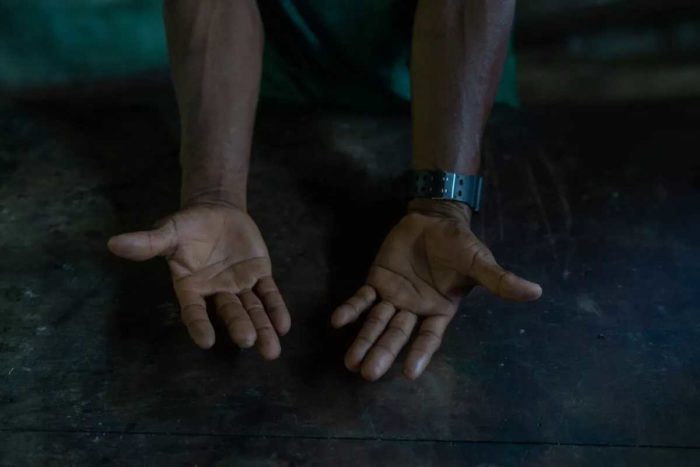
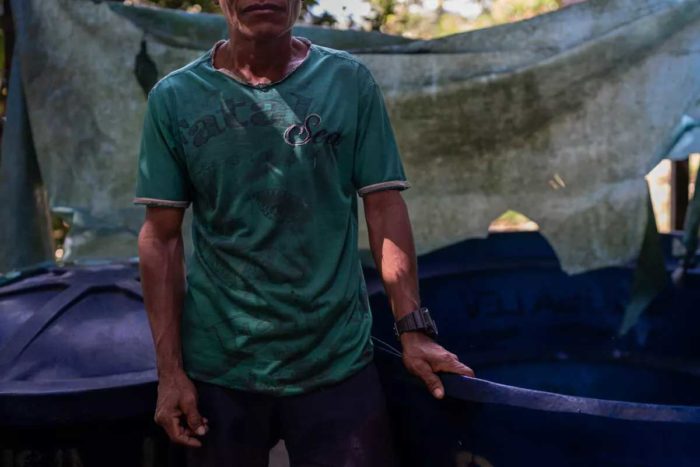
“It’s safe over there, it’s a good place to work. It’s not dangerous. You just have to do the work, then leave,” he said in heavily accented Portuguese that gave away his Peruvian origins. Juan claimed that, in general, he also earns 60 reais ($11.50) per day of work in the fields, taking 1.5 reais ($0.30) for each kilo of coca leaves harvested, and managing to harvest up to 40 kilos of coca leaves on a good day of work. The leaves are then handed over to other workers, who work in the production of the coca paste in laboratories concealed within the middle of the rainforest. The most he has ever earned working in the coca fields was 5,000 reais ($957) in a month. He said that he had heard many stories of Brazilian workers being killed for attempting to steal from the coca bosses. “They [the bosses] prefer Indigenous workers because they don’t steal,” Juan claimed.
Wesley Urzêda, from the Federal Police of Tabatinga, spoke about the challenges of policing the vast expanse of the Amazonian Trapezium, where drugs are smuggled through the world’s largest water basin. This is especially difficult when the river is at its high water level, as the “furos”, or smaller waterways, provide traffickers with an abundance of routes for their boats to smuggle their illicit cargo through the region. “The countries neighboring Brazil produce the cocaine which is sold across the world. A large part of it is smuggled via waterways. The Federal Police’s inspection efforts are focused on specific points, [and] seizures take place regularly,” Urzêda told Agência Pública.
Employees of the National Indian Foundation (Funai), who spoke to Agência Pública anonymously for fear of internal reprisals within the public body, said that they are aware of the drug trafficking industry’s assault on Indigenous lands.
“Funai doesn’t have the same power as the police, it doesn’t have the manpower… generally, it only forwards reports to the Federal Police, [and] the Public Prosecutor’s Office,” said one employee. “The Federal Police are also short-staffed. They have never really bothered themselves with Indigenous issues, they just let things go on as they are (…) And drug trafficking is becoming an increasingly serious issue with the arrival of [rival] factions [from organized crime groups],” the Funai employee claimed.
There is an ongoing dispute between Brazil’s rival criminal gangs for control of the drug smuggling routes in the triple border area, something that has led to a significant increase in violence in the region. Between 2019 and 2021, Tabatinga registered a 1,600% increase in the number of homicides, according to data from the Department for Public Security of the state of Amazonas.
Graffiti tags referring to criminal gangs active in the area are a common sight on the walls of buildings in the Indigenous communities visited by Agência Pública’s reporters, such as tags referring to one of Brazil’s oldest and foremost criminal gangs, Comando Vermelho, formed in Rio de Janeiro, and to Os Crias, a recently established local faction in the triple border area.
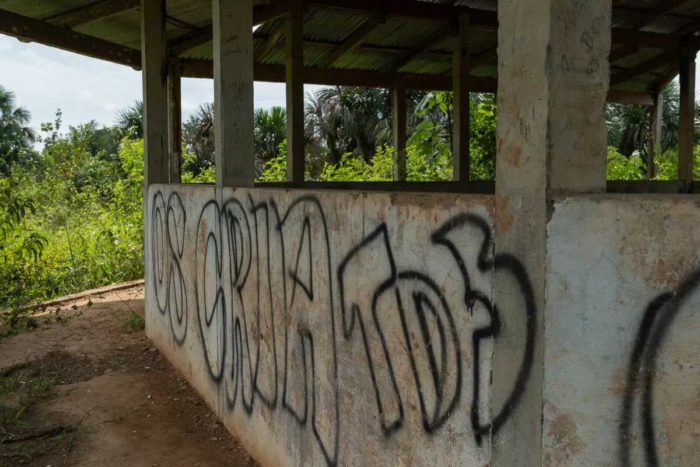
Pedro Rapozo, the coordinator of the Amazonas Center for Socio-Environmental Studies (NESAM), highlighted the contrast between the Brazilian State’s levels of disorganization and the degree of coordination seen among criminal organizations.
“You can see an absence of inspections and monitoring in these areas, which leaves these territories vulnerable. Insofar as there is this absence of the State, you see, on the other hand, criminal organizations that manage networks of contact and communication, including with the indigenous people themselves, working with and enticing people from families and communities who have few other possibilities and who don’t receive any assistance from the government,” Rapozo evaluated. “It is not simply a question of criminalizing these people who are involved in drug trafficking networks and illicit markets. It’s much bigger than that: it’s about the lack of opportunities and government policies that would assist and enable local populations to generate an income,” he underlined.
Rapozo also pointed to the contradiction of what he has started to call the “present absence” of the State in his research work. “Here you have the Federal Police, the Public Prosecutor’s Office, Funai, [and] the Armed Forces, but these institutions are ineffective [in their current state],” he argued.
*Names in this report have been changed to protect the identities of those interviewed
The Vale do Javari – terra de conflitos e crime organizado [Vale do Javari – land of conflicts and organized crime] special report is part of a series of reports by Agência Pública, carried out with the support of the Amazon Rainforest Journalism Fund (Amazon RJF) in partnership with the Pulitzer Center.

